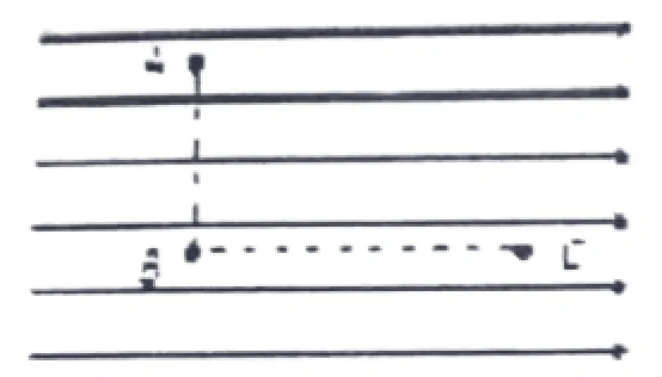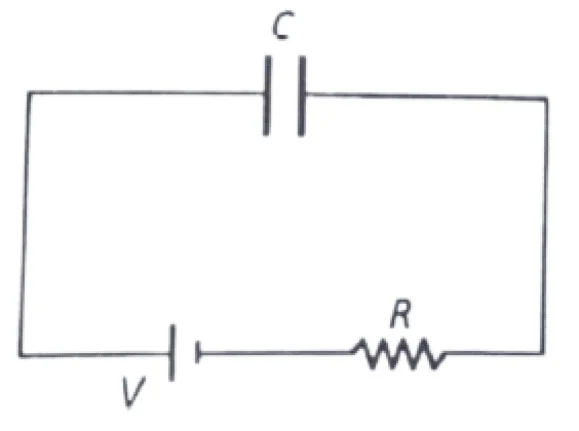Physics Chapter 6 Entry test MCQs
26. The electric field intensity at a point situated 4 meters from a point charge is 200 N/C. If the distance is reduced to 2 meters, the field intensity will be
a. 600 N/C
b. 400 N/C
c. 1200 N/C
d. 800 N/C
27. The lines of force due to charged particles are
a. Always curved
b. Always straight
c. Sometimes curved
d. None of the above
28. Two thin infinite parallel plates have uniform charge densities sigma and -σ. The electric field in the space between them is
a. σ/Eο
b. σ/200
c. zero
d. σ
29. Gauss’s law is applied to calculate the
a. Electric intensity due to negative charges only
b. Electric intensity due to different charge configuration
c. Electric intensity due to positive charges only
d. None of these
30. Electric intensity due to an infinite sheet of positive charge is given by

31. The capacity of a parallel plate capacitor is 5μF When a glass plate is placed between the plates of the capacitor, its potential becomes 1/8 of the original value. The value of dielectric constant will be
a. 5
b. 1.6
c. 40
d. 8
32. Two charged spheres of radii 10 cm and 15 cm are connected by a thin wire. No current will flow, if they have:
a. The same potential
b. The same charge on each
c. The same field on their surface
d. The same energy
33. A and B are two points in an electric field. If the work done in carrying 4.0 coulomb of electric charge from A to B is 16.0 joule the potential difference between A and B is
a. 2.0 V
b. Zero
c. 16V
d. 4 V
34. Potential due to charge q at distance 1m is 5V, at distance 3m will be
a. 3/5 V
b. 5/3 v
c. 3/7 V
d. 7/3V
35. The electric potential at the surface of an atomic nucleus (Z = 50) of radius 9 x 10-15 r is
a. 9 x 105V
b. 9V
c. 80 V
d. 8 x 106 V
36. A capacitor with air as the dielectric is charged to a potential of 100 volts. If the space between the plate is now filled with a dielectric of dielectric constant 10, the potential difference the plates will be
a. 1000V
b. 10V
c. 100V
d. 0V
37. Figure shows three points A,B and C in a region of uniform of electric field. The Line A and B is Perpendicular and BC is parallel to the field lines. The which of the following holds good. Where VA , VB and VC represent the electric potential at points A, B and C respectively

a. VA = VB = VC
b. VA = VB < VC
c. VA = VB > VC
d. VA > VB = VC
38. Value of potential at a point due to a point charge is
a. Directly proportional to square of the distance
b. A Inversely proportional to square of the distance
c. Directly proportional to the distance
d. Inversely proportional to the distance
39. Equal amount of charge is given to two sphere A and B of radii 2cm and 3cm respectively. The potential VA and VB
a. VA < VB
b. VA = VB
c. Depend upon number of material of sphere
d. VA > VB
40. Two charge +q and -q are situated at a certain distance. At the point exactly midway between them
a. Electric field is zero but potential is not zero
b. Electric field and potential both are zero
c. Electric field is not zero but potential is zero
d. Electric field is not zero but potential is zero
41. An-alpha-particle is accelerated through a potential difference of 106 V. Its K.E will be
a. 2MeV
b. 1 MeV
c. 8MeV
d. 4 MeV
42. A capacitor C “has a charge Q”. The actual charges on its plates are
a. Q, Q
b. Q,-Q
c. Q,0
d. Q/2, – Q / 2
43. As in figure shown, if a capacitor is charged by connecting it with resistance R, then energy is given by the battery will be.

a. 1/2 CV2
b. Less Than 1/2 CV2
c. More Than 1/2 CV2
d. Zero
44. A capacitor of capacitance 2µF is connected with a battery of 12 volt, the charge stored is equal to:
a. 2.4 x 10-5C
b. 2.5 x 10-5C
c. 2.5 x 10-5C
d. 2.4 x 10-6C
45. Ifa 3 µF capacitor has a charge of 20 µC, the potential difference between the plates is:
a. 40 V
b. 10 V
c. 50V
d. 20V
46. If a 6 µF capacitor is charged to 200 V, the charge in coulombs will be
a. 900 με
b. 800 με
c. 1600 μC
d. 1200 με
47. What is the area of the plates of a 3F parallel plate capacitor, if the separation between the plates is 5mm?
a. 4.529 x 109 m2
b. 1.694 x 109 m2
c. 12.981 x 109 m
d. 9.281 x 109 m2
48. The capacity of a condenser in which a dielectric constant 5 has been used, is C. If the dielectric is replaced by another with dielectric constant 20, the capacity will become
a. 4C
b. C/4
c. 2C
d. C/2
49. The space between the plates of a capacitor is filled by a dielectric constant k. The capacitance of the capacitor
a. Increases by a factor k2
b. Increases by a factor k
c. Decreases by a factor k2
d. Decreases by a factor k
50. If an insulating material called dielectric is introduced between the plates, the capacitance of capacitor is:
a. (Ad)/εoεr
b. (Aεo-εr/(2d)
c. 2Adεoεr/d
d. Aεoεr/d
